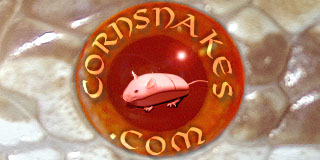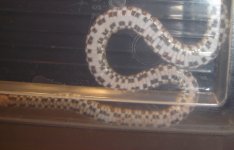Well, we all know that Serp is always right, but there are some genes that cause that kind of belly pattern. The problem is that they all look about the same, and like Serp said, it is possible to get that belly pattern without any mutant genes involved. I am not sure how we would know this, however; unless we bred a suspect to all possible causes of this pattern.
I only have experience with two genes that seem to cause this belly pattern. The Bloodred gene we all know can certainly cause this type of belly pattern as het. I have heard on this forum that the hets for Banded often exhibit this pattern as well.
You may have heard that the Striped Gene seems to cause this pattern from me. I haven’t had anybody challenge this theory or cooberated it either. I find it hard to believe that only my Striped Line causes this belly pattern as het. The belly pattern on your snake is pretty extreme. I have noticed that ALL of my known hets for Striped have a stripe down the middle of their belly on at least the last half of their belly. On some it is just a strip, and on others it looks like yours.
There are always those that don’t quite seem to fit the model and are questionable, but those are usually the poss hets for Striped. I am not saying that you can pick out possible hets, but there is an extremely high percentage of known hets for Striped that have a very distinctive stripe down the middle of their belly pattern. Since a Striped has a plain belly pattern, this would be consistent with a co-dominant type gene having an effect on the belly pattern. It is not much to go on, but co-dominant genes can be very variable and perhaps only show minimal signs of the co-dominance. The puzzling factor to me is that I do not see this with Hets for Motley, and if they are alleles, I would think they would have to be similar type genes, such as both recessive or both co-dominant. Some people do think they can see some pattern differences in Hets for Motley, so it is possible.
In the Corn Snake World we have lumped almost all of our mutant genes into a group of recessives, when in the Boa World they almost automatically lump them into a co-dominant group. Perhaps if the co-dominant effect with normal is very slight, we have been over looking the subtle differences and been classifying them as recessive when perhaps they are not.
I have been getting a lot of odd belly patterns from some of my Rich Z stock. It is a shot in the dark, but why not match them up with a Blood, Banded, or Striped and see if I can get a match?



